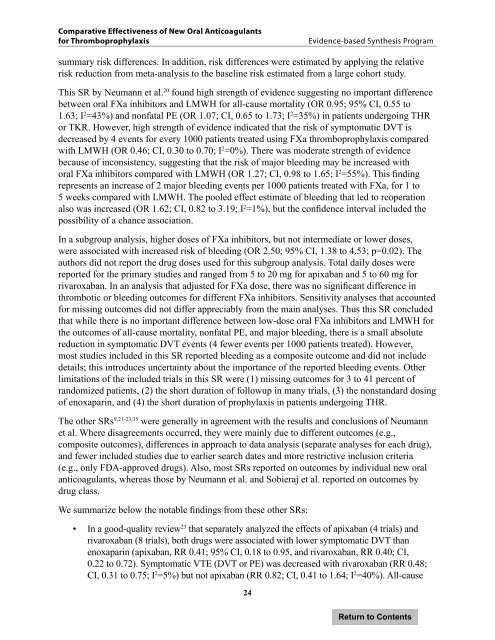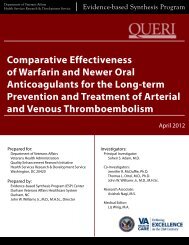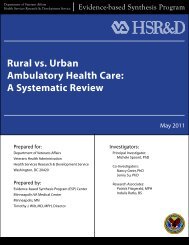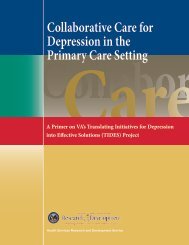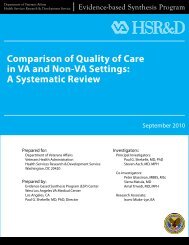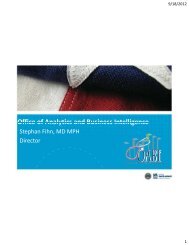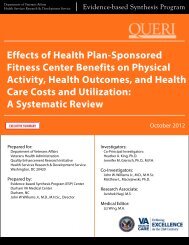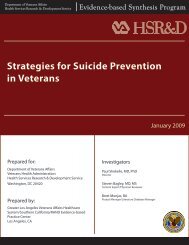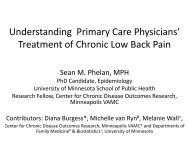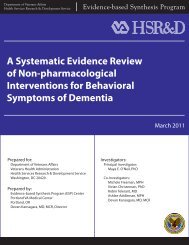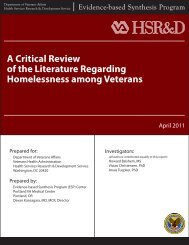Comparative Effectiveness of New Oral Anticoagulants for ...
Comparative Effectiveness of New Oral Anticoagulants for ...
Comparative Effectiveness of New Oral Anticoagulants for ...
Create successful ePaper yourself
Turn your PDF publications into a flip-book with our unique Google optimized e-Paper software.
<strong>Comparative</strong> <strong>Effectiveness</strong> <strong>of</strong> <strong>New</strong> <strong>Oral</strong> <strong>Anticoagulants</strong><br />
<strong>for</strong> Thromboprophylaxis<br />
Evidence-based Synthesis Program<br />
summary risk differences. In addition, risk differences were estimated by applying the relative<br />
risk reduction from meta-analysis to the baseline risk estimated from a large cohort study.<br />
This SR by Neumann et al. 20 found high strength <strong>of</strong> evidence suggesting no important difference<br />
between oral FXa inhibitors and LMWH <strong>for</strong> all-cause mortality (OR 0.95; 95% CI, 0.55 to<br />
1.63; I 2 =43%) and nonfatal PE (OR 1.07; CI, 0.65 to 1.73; I 2 =35%) in patients undergoing THR<br />
or TKR. However, high strength <strong>of</strong> evidence indicated that the risk <strong>of</strong> symptomatic DVT is<br />
decreased by 4 events <strong>for</strong> every 1000 patients treated using FXa thromboprophylaxis compared<br />
with LMWH (OR 0.46; CI, 0.30 to 0.70; I 2 =0%). There was moderate strength <strong>of</strong> evidence<br />
because <strong>of</strong> inconsistency, suggesting that the risk <strong>of</strong> major bleeding may be increased with<br />
oral FXa inhibitors compared with LMWH (OR 1.27; CI, 0.98 to 1.65; I 2 =55%). This finding<br />
represents an increase <strong>of</strong> 2 major bleeding events per 1000 patients treated with FXa, <strong>for</strong> 1 to<br />
5 weeks compared with LMWH. The pooled effect estimate <strong>of</strong> bleeding that led to reoperation<br />
also was increased (OR 1.62; CI, 0.82 to 3.19; I 2 =1%), but the confidence interval included the<br />
possibility <strong>of</strong> a chance association.<br />
In a subgroup analysis, higher doses <strong>of</strong> FXa inhibitors, but not intermediate or lower doses,<br />
were associated with increased risk <strong>of</strong> bleeding (OR 2.50; 95% CI, 1.38 to 4.53; p=0.02). The<br />
authors did not report the drug doses used <strong>for</strong> this subgroup analysis. Total daily doses were<br />
reported <strong>for</strong> the primary studies and ranged from 5 to 20 mg <strong>for</strong> apixaban and 5 to 60 mg <strong>for</strong><br />
rivaroxaban. In an analysis that adjusted <strong>for</strong> FXa dose, there was no significant difference in<br />
thrombotic or bleeding outcomes <strong>for</strong> different FXa inhibitors. Sensitivity analyses that accounted<br />
<strong>for</strong> missing outcomes did not differ appreciably from the main analyses. Thus this SR concluded<br />
that while there is no important difference between low-dose oral FXa inhibitors and LMWH <strong>for</strong><br />
the outcomes <strong>of</strong> all-cause mortality, nonfatal PE, and major bleeding, there is a small absolute<br />
reduction in symptomatic DVT events (4 fewer events per 1000 patients treated). However,<br />
most studies included in this SR reported bleeding as a composite outcome and did not include<br />
details; this introduces uncertainty about the importance <strong>of</strong> the reported bleeding events. Other<br />
limitations <strong>of</strong> the included trials in this SR were (1) missing outcomes <strong>for</strong> 3 to 41 percent <strong>of</strong><br />
randomized patients, (2) the short duration <strong>of</strong> followup in many trials, (3) the nonstandard dosing<br />
<strong>of</strong> enoxaparin, and (4) the short duration <strong>of</strong> prophylaxis in patients undergoing THR.<br />
The other SRs 9,21-23,35 were generally in agreement with the results and conclusions <strong>of</strong> Neumann<br />
et al. Where disagreements occurred, they were mainly due to different outcomes (e.g.,<br />
composite outcomes), differences in approach to data analysis (separate analyses <strong>for</strong> each drug),<br />
and fewer included studies due to earlier search dates and more restrictive inclusion criteria<br />
(e.g., only FDA-approved drugs). Also, most SRs reported on outcomes by individual new oral<br />
anticoagulants, whereas those by Neumann et al. and Sobieraj et al. reported on outcomes by<br />
drug class.<br />
We summarize below the notable findings from these other SRs:<br />
• In a good-quality review 23 that separately analyzed the effects <strong>of</strong> apixaban (4 trials) and<br />
rivaroxaban (8 trials), both drugs were associated with lower symptomatic DVT than<br />
enoxaparin (apixaban, RR 0.41; 95% CI, 0.18 to 0.95, and rivaroxaban, RR 0.40; CI,<br />
0.22 to 0.72). Symptomatic VTE (DVT or PE) was decreased with rivaroxaban (RR 0.48;<br />
CI, 0.31 to 0.75; I 2 =5%) but not apixaban (RR 0.82; CI, 0.41 to 1.64; I 2 =40%). All-cause<br />
24


